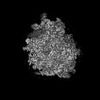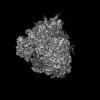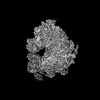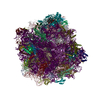+ Open data
Open data
- Basic information
Basic information
| Entry |  | |||||||||||||||
|---|---|---|---|---|---|---|---|---|---|---|---|---|---|---|---|---|
| Title | dormant ribosome with STM1 | |||||||||||||||
 Map data Map data | ||||||||||||||||
 Sample Sample |
| |||||||||||||||
 Keywords Keywords | Ribosome / STM1 | |||||||||||||||
| Biological species |  | |||||||||||||||
| Method | single particle reconstruction / cryo EM / Resolution: 3.59 Å | |||||||||||||||
 Authors Authors | Du M / Zeng F | |||||||||||||||
| Funding support |  China, 4 items China, 4 items
| |||||||||||||||
 Citation Citation |  Journal: Front Mol Biosci / Year: 2024 Journal: Front Mol Biosci / Year: 2024Title: Implication of Stm1 in the protection of eIF5A, eEF2 and tRNA through dormant ribosomes. Authors: Mengtan Du / Xin Li / Wanlin Dong / Fuxing Zeng /  Abstract: Dormant ribosomes are typically associated with preservation factors to protect themselves from degradation under stress conditions. Stm1/SERBP1 is one such protein that anchors the 40S and 60S ... Dormant ribosomes are typically associated with preservation factors to protect themselves from degradation under stress conditions. Stm1/SERBP1 is one such protein that anchors the 40S and 60S subunits together. Several proteins and tRNAs bind to this complex as well, yet the molecular mechanisms remain unclear. Here, we reported the cryo-EM structures of five newly identified Stm1/SERBP1-bound ribosomes. These structures highlighted that eIF5A, eEF2, and tRNA might bind to dormant ribosomes under stress to avoid their own degradation, thus facilitating protein synthesis upon the restoration of growth conditions. In addition, Ribo-seq data analysis reflected the upregulation of nutrient, metabolism, and external-stimulus-related pathways in the strain, suggesting possible regulatory roles of Stm1. The knowledge generated from the present work will facilitate in better understanding the molecular mechanism of dormant ribosomes. | |||||||||||||||
| History |
|
- Structure visualization
Structure visualization
| Supplemental images |
|---|
- Downloads & links
Downloads & links
-EMDB archive
| Map data |  emd_37994.map.gz emd_37994.map.gz | 51.9 MB |  EMDB map data format EMDB map data format | |
|---|---|---|---|---|
| Header (meta data) |  emd-37994-v30.xml emd-37994-v30.xml emd-37994.xml emd-37994.xml | 14.5 KB 14.5 KB | Display Display |  EMDB header EMDB header |
| FSC (resolution estimation) |  emd_37994_fsc.xml emd_37994_fsc.xml | 13.6 KB | Display |  FSC data file FSC data file |
| Images |  emd_37994.png emd_37994.png | 126.7 KB | ||
| Filedesc metadata |  emd-37994.cif.gz emd-37994.cif.gz | 4 KB | ||
| Others |  emd_37994_half_map_1.map.gz emd_37994_half_map_1.map.gz emd_37994_half_map_2.map.gz emd_37994_half_map_2.map.gz | 172 MB 171.7 MB | ||
| Archive directory |  http://ftp.pdbj.org/pub/emdb/structures/EMD-37994 http://ftp.pdbj.org/pub/emdb/structures/EMD-37994 ftp://ftp.pdbj.org/pub/emdb/structures/EMD-37994 ftp://ftp.pdbj.org/pub/emdb/structures/EMD-37994 | HTTPS FTP |
-Validation report
| Summary document |  emd_37994_validation.pdf.gz emd_37994_validation.pdf.gz | 1013.5 KB | Display |  EMDB validaton report EMDB validaton report |
|---|---|---|---|---|
| Full document |  emd_37994_full_validation.pdf.gz emd_37994_full_validation.pdf.gz | 1013.1 KB | Display | |
| Data in XML |  emd_37994_validation.xml.gz emd_37994_validation.xml.gz | 21.2 KB | Display | |
| Data in CIF |  emd_37994_validation.cif.gz emd_37994_validation.cif.gz | 28 KB | Display | |
| Arichive directory |  https://ftp.pdbj.org/pub/emdb/validation_reports/EMD-37994 https://ftp.pdbj.org/pub/emdb/validation_reports/EMD-37994 ftp://ftp.pdbj.org/pub/emdb/validation_reports/EMD-37994 ftp://ftp.pdbj.org/pub/emdb/validation_reports/EMD-37994 | HTTPS FTP |
-Related structure data
- Links
Links
| EMDB pages |  EMDB (EBI/PDBe) / EMDB (EBI/PDBe) /  EMDataResource EMDataResource |
|---|
- Map
Map
| File |  Download / File: emd_37994.map.gz / Format: CCP4 / Size: 216 MB / Type: IMAGE STORED AS FLOATING POINT NUMBER (4 BYTES) Download / File: emd_37994.map.gz / Format: CCP4 / Size: 216 MB / Type: IMAGE STORED AS FLOATING POINT NUMBER (4 BYTES) | ||||||||||||||||||||||||||||||||||||
|---|---|---|---|---|---|---|---|---|---|---|---|---|---|---|---|---|---|---|---|---|---|---|---|---|---|---|---|---|---|---|---|---|---|---|---|---|---|
| Projections & slices | Image control
Images are generated by Spider. | ||||||||||||||||||||||||||||||||||||
| Voxel size | X=Y=Z: 1.08 Å | ||||||||||||||||||||||||||||||||||||
| Density |
| ||||||||||||||||||||||||||||||||||||
| Symmetry | Space group: 1 | ||||||||||||||||||||||||||||||||||||
| Details | EMDB XML:
|
-Supplemental data
-Half map: #1
| File | emd_37994_half_map_1.map | ||||||||||||
|---|---|---|---|---|---|---|---|---|---|---|---|---|---|
| Projections & Slices |
| ||||||||||||
| Density Histograms |
-Half map: #2
| File | emd_37994_half_map_2.map | ||||||||||||
|---|---|---|---|---|---|---|---|---|---|---|---|---|---|
| Projections & Slices |
| ||||||||||||
| Density Histograms |
- Sample components
Sample components
-Entire : dormant ribosome
| Entire | Name: dormant ribosome |
|---|---|
| Components |
|
-Supramolecule #1: dormant ribosome
| Supramolecule | Name: dormant ribosome / type: complex / ID: 1 / Parent: 0 / Details: dormant ribosome purified from yeast |
|---|---|
| Source (natural) | Organism:  |
-Experimental details
-Structure determination
| Method | cryo EM |
|---|---|
 Processing Processing | single particle reconstruction |
| Aggregation state | particle |
- Sample preparation
Sample preparation
| Buffer | pH: 7.4 Details: 50mM HEPES, pH 7.4, 100 mM KOAc, 5 mM Mg(OAc)2, 1mM DTT |
|---|---|
| Grid | Model: Quantifoil R1.2/1.3 / Material: COPPER / Mesh: 300 / Support film - Material: CARBON / Support film - topology: CONTINUOUS / Support film - Film thickness: 4 / Pretreatment - Type: GLOW DISCHARGE / Pretreatment - Time: 30 sec. / Pretreatment - Atmosphere: AIR |
| Vitrification | Cryogen name: ETHANE / Chamber humidity: 100 % / Chamber temperature: 277 K / Instrument: FEI VITROBOT MARK II |
- Electron microscopy
Electron microscopy
| Microscope | FEI TITAN KRIOS |
|---|---|
| Image recording | Film or detector model: GATAN K3 (6k x 4k) / Average electron dose: 30.0 e/Å2 |
| Electron beam | Acceleration voltage: 300 kV / Electron source:  FIELD EMISSION GUN FIELD EMISSION GUN |
| Electron optics | Illumination mode: FLOOD BEAM / Imaging mode: BRIGHT FIELD / Nominal defocus max: 2.5 µm / Nominal defocus min: 1.5 µm |
| Experimental equipment |  Model: Titan Krios / Image courtesy: FEI Company |
 Movie
Movie Controller
Controller











 Z (Sec.)
Z (Sec.) Y (Row.)
Y (Row.) X (Col.)
X (Col.)






































